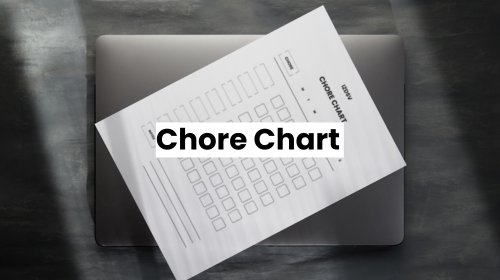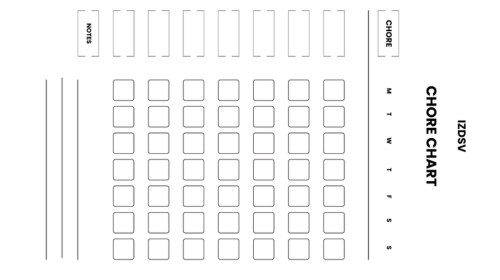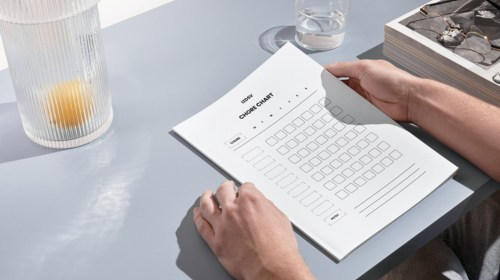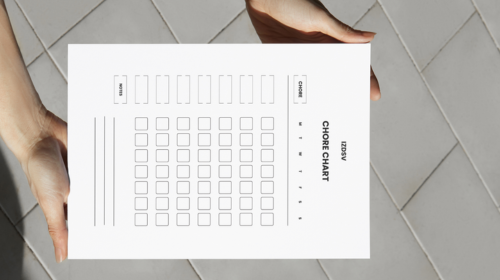Personalized Chore Chart – Custom Designs to Organize Weekly Tasks
What is a Personalized Chore Chart?
A personalized chore chart is a customized system for organizing and tracking household tasks assigned to family members. It’s designed to match the specific needs, preferences, and schedules of individuals within a household.
- A visual representation of responsibilities tailored to an individual’s age, abilities, and schedule
- Typically includes names, specific tasks, timeframes, and often a reward or tracking system
- It can be physical (printed charts, magnetic boards) or digital (apps, Notion, spreadsheets)
- Customized to reflect personal preferences and household-specific needs
Definition and Purpose of a Chore Chart
A chore chart is a structured organizational tool that visually displays household tasks and who is responsible for completing them. Its primary purpose is to clearly communicate expectations and responsibilities while providing a system for accountability and reward.
- It helps distribute household labor fairly among family members
- It creates clear expectations for what needs to be done and when
- Provides visual tracking of task completion and progress
- It establishes a system for accountability and responsibility
- Can include incentives or rewards for completed tasks
- It reduces the need for verbal reminders and potential conflicts
Benefits of Using a Personalized Chore Chart
The benefits of using a personalized chore chart extend beyond simple task management to include valuable life skill development and improved household dynamics. They create structure and help establish important habits while reducing stress and conflict.
- Teaches responsibility, time management, and accountability
- Reduces parental nagging and household tension
- It creates a sense of contribution and teamwork among family members
- Develops independence and self-sufficiency in children
- It ensures fair distribution of household tasks
- Provides visual satisfaction when tasks are completed
- It can reduce the mental load on the primary household manager
- It helps establish consistent routines and habits
Different Types of Chore Charts Available
There are numerous types of chore charts available, each with different features and formats to suit various family needs and preferences. The right choice depends on factors like family size, ages of children, and personal organization style.
- Age-specific charts (picture-based for young children, text-based for older children)
- Weekly rotation charts (tasks rotate between family members each week)
- Magnetic or dry-erase boards for easy updating
- Digital apps and online tools with reminders and tracking features
- Reward-based systems with point tracking and incentives
- Daily vs. weekly task organization
- Task-specific charts (focusing on morning routines, after-school responsibilities, etc.)
- Combined family calendars with chore assignments integrated
How to Create a Customizable Chore Chart?
Creating a customizable chore chart involves thoughtful planning and execution to ensure it meets your household’s specific needs. The process typically begins with identifying all necessary tasks and considering who will be responsible for them.
- Identify all household tasks that need to be completed regularly
- Categorize tasks by frequency (daily, weekly, monthly)
- Assess the age-appropriateness and capability of each family member
- Determine if tasks will be assigned permanently or rotated
- Decide on your tracking method (checkmarks, stickers, digital tracking)
- Choose a visual format that works for your family (calendar style, list format, etc.)
- Include clear instructions for complex tasks if needed
- Consider adding a reward or incentive system
- Plan for regular reviews and adjustments as needed
Steps to Personalize Your Chore Chart
Personalizing your chore chart effectively requires a systematic approach to ensure it resonates with each family member and addresses your household’s unique dynamics. The customization process should involve all family members to increase buy-in and commitment.
- Host a family meeting to discuss expectations and gather input
- Consider each person’s schedule, preferences, and abilities
- Add personal touches like favorite colors or themes for each family member
- Include photographs or personalized icons for younger children
- Adjust task difficulty based on age and development
- Create a balance between preferred and less desirable tasks
- Set realistic timeframes for completion based on individual abilities
- Incorporate individual goals or focus areas for each person
- Use positive, encouraging language in task descriptions
Recommended Tools for Creating a Chore Chart
Several tools can make creating and maintaining a chore chart easier, ranging from simple analog options to sophisticated digital solutions. The best tool depends on your family’s tech preferences and how you plan to use the chart.
- Whiteboard or magnetic board with markers or magnets
- Laminated printed charts with dry-erase markers
- Digital spreadsheet programs like Notion, Excel, or Google Sheets
- Specialized chore chart apps (ChoreMonster, OurHome, Cozi)
- Online design tools like Canva or PicMonkey
- Printable templates from websites like Pinterest or Gumroad
- Smart home assistants for reminders and tracking
- Stickers, colored markers, and other craft supplies
- Pocket chart systems with movable cards
- Scheduling software with shared family access
Templates for Personalized Chore Charts
Templates provide excellent starting points for creating personalized chore charts without having to design from scratch. Many options are available to suit different family styles and needs.
- Weekly grid templates with family members listed across the top and days down the side
- Visual checklist templates with picture cues for young children
- Behavioral chart templates that combine chores with other desired behaviors
- Responsibility pie charts showing fair distribution of household tasks
- Morning and evening routine charts for daily habits
- Rotating wheel templates for chore rotation systems
- Reward-tracking templates with point systems
- Seasonal chore charts for changing household needs
- Age-specific templates for different developmental stages
- Printable magnet or sticker templates for interactive charts
What are the Best Features of a Weekly Chore Chart?
Weekly chore charts shine through their ability to establish consistent routines while maintaining flexibility for changing family needs. They provide the perfect balance between structure and adaptability that helps families stay organized without feeling overwhelmed.
- A clear day-by-day breakdown of responsibilities
- Visual overview of the entire week’s tasks at a glance
- Space for both recurring daily tasks and weekly special projects
- Ability to track completion with checkmarks or stickers
- Designated accountability for each family member
- Flexibility to adjust tasks based on changing weekly schedules
- Balance between weekday and weekend responsibilities
- Option to incorporate both individual and shared family tasks
- Weekly reset point to celebrate accomplishments and start fresh
Essential Elements of a Weekly Chore Chart
A well-designed weekly chore chart contains several key elements that make it functional and effective for family use. These essential components ensure the chart serves its purpose of organizing household responsibilities and promoting accountability.
- Names or photos of each family member clearly displayed
- Tasks written in simple, actionable language
- Visual completion indicators (checkboxes, sticker spaces)
- Timeframes for task completion (morning, after school, before bed)
- Space for parent/guardian signatures or verification
- Balance of tasks appropriate to each person’s age and ability
- A clear distinction between daily habits and weekly chores
- Space for notes or special instructions
- Weekly summary or totals section for tracking progress
- Durable, practical format that withstands regular use
Customizable Options for Every Family
The best chore charts offer customization options that allow families to tailor them to their unique household dynamics and preferences. Adaptability is key to creating a system that truly works for your specific family situation.
- Color-coding options for different family members or task types
- Adjustable task difficulty levels based on age and ability
- Digital vs. physical format options to match family tech preferences
- Adjustable frequency settings for different tasks
- Icons or images for non-readers
- Space for adding or removing tasks as needed
- Multiple tracking methods (digital check-ins, stickers, initials)
- Personalized themes or designs that appeal to children
- Options for temporary or seasonal tasks
- Integration with family calendars or scheduling systems
Incorporating Rewards into the Chore Chart
Incorporating rewards into your chore chart system can significantly boost motivation and participation, especially for children. An effective reward structure should balance intrinsic and extrinsic motivation while teaching valuable life lessons.
- Point-based systems where tasks earn varying points based on difficulty
- Tiered reward options at different point thresholds
- Combination of immediate small rewards and larger long-term incentives
- Non-monetary rewards like special privileges or activities
- Family celebration rewards that everyone works toward together
- Visual progress trackers that show advancement toward reward goals
- Age-appropriate reward options for different family members
- A balance between individual rewards and group/family rewards
- Surprise bonus rewards for exceptional effort or attitude
- A clear connection between effort and reward to reinforce cause-effect relationships
How to Use a Chore Chart for Kids Effectively?
Using a chore chart effectively with kids requires consistent implementation and positive reinforcement to build lasting habits. The key is to make the chart a helpful tool rather than a source of tension or pressure.
- Start with a clear explanation of how the chart works and why it’s important
- Keep the system simple, especially when first introducing it
- Be consistent with checking and acknowledging completed tasks
- Use the chart as a visual reminder rather than a nagging tool
- Involve children in creating and updating their charts
- Celebrate successes and progress, not just perfect completion
- Use positive language around responsibilities and contributions
- Model task completion yourself with your own chores
- Make checking the chart part of daily routines
- Adjust expectations and tasks as needed based on results
Age-Appropriate Tasks for Children
Assigning age-appropriate tasks is crucial for building confidence and ensuring children can successfully complete their responsibilities. The right balance challenges children while setting them up for success.
- Ages 2-3: Simple matching tasks like putting toys in a bin, helping set the table
- Ages 4-5: Making their bed, sorting laundry, watering plants
- Ages 6-7: Emptying small trash bins, helping with meal prep, folding simple laundry
- Ages 8-9: Loading dishwasher, vacuuming, taking out trash, simple meal preparation
- Ages 10-12: Washing dishes, laundry cycles, cooking simple meals, yard work
- Ages 13-15: Lawn mowing, deeper cleaning tasks, meal planning and cooking
- Ages 16+: Car maintenance, grocery shopping, managing household systems
- All ages: Personal responsibilities like clothing care and personal hygiene
- Consider individual development, not just chronological age
- Gradually increase complexity as skills develop
Engaging Kids with a Fun Chore Chart
Creating an engaging and fun chore chart can transform household tasks from dreaded chores to enjoyable activities. The more appealing and interactive the chart, the more likely children will participate willingly.
- Use bright colors, favorite characters, or themes that interest your child
- Incorporate playful elements like stickers, stamps, or colorful markers
- Add a game-like component with challenges or “level-ups”
- Include a photo of the child completing the task as a visual guide
- Create a “chore challenge” with timed activities when appropriate
- Use digital apps with fun sounds, animations, or character development
- Incorporate storytelling elements where tasks advance a narrative
- Add surprise elements or mystery tasks occasionally
- Consider cooperative tasks where siblings work together
- Include occasional “parent’s choice” tasks where kids get to assign a chore to parents
Tracking Progress with a Responsibility Chart
Tracking progress effectively with a responsibility chart helps children visualize their accomplishments and builds intrinsic motivation. A good tracking system balances accountability with positive reinforcement.
- Use visual progress indicators like stickers, stamps, or colored markers
- Include a weekly summary section to highlight improvement over time
- Take photos of completed tasks for digital charts or memory books
- Track streaks of consecutive days completing specific tasks
- Use progressively filling containers or growing visual elements
- Include space for qualitative feedback, not just task completion
- Consider tracking effort or attitude alongside task completion
- Create milestone celebrations for consistent participation
- Use symbols or ratings for quality of work when appropriate
- Include a reflection component where children can note how they feel about their progress
What Makes Acrylic Chore Charts Unique?
Acrylic chore charts combine sleek, modern aesthetics with practical functionality to create an elegant organizational solution for any home. These durable, transparent charts offer a contemporary look that blends with home decor while providing all the benefits of traditional chore tracking systems.
- Made from clear, glass-like acrylic material that’s more durable than paper or cardboard
- Professional appearance with customizable printing directly on the surface
- Typically wall-mountable with pre-drilled holes or included hardware
- Crystal-clear transparency creates a floating effect against walls
- Smooth surface ideal for dry-erase markers
- UV-resistant properties prevent yellowing or degradation over time
- Premium weight and feel compared to laminated alternatives
- Often feature beveled or polished edges for a finished look
- Can include standoffs for a dimensional, floating appearance
- Wipe-clean surface maintains a consistently fresh appearance
Benefits of Using Acrylic for Chore Charts
Acrylic material offers several significant advantages that make it particularly well-suited for long-term household organization tools like chore charts. The investment in an acrylic chart often pays off through extended durability and enhanced functionality.
- Exceptional durability with resistance to cracking, breaking, and warping
- Waterproof surface that won’t be damaged by moisture or humidity
- Easy to clean and disinfect for high-touch family surfaces
- Non-porous material doesn’t absorb stains or odors
- Significant weight and stability compared to paper alternatives
- Crystal clarity maintains the visibility of information
- Modern, upscale appearance that looks intentional in home decor
- Environmentally friendly as a reusable alternative to disposable paper charts
- Scratch-resistant when used with appropriate markers
- Long-term cost savings from not needing replacements
Dry Erase Features for Flexibility
The dry-erase compatibility of acrylic chore charts provides unmatched flexibility for families with changing needs and schedules. This feature transforms the chart from a static tool to a dynamic planning system.
- Write, erase, and update tasks instantly without waste
- Ability to change assigned responsibilities as needs evolve
- Color-coding options with different dry-erase marker colors
- Weekly reset without printing new templates
- Easy modification for school breaks, vacations, or special circumstances
- Test different task distributions without commitment
- Combine permanent printed elements with changeable written portions
- Quick adjustments for unexpected events or schedule changes
- Practice proper erasing techniques to maintain clarity
- Compatible with both standard dry-erase markers and specialty fine-tip versions
Design Options for Acrylic Chore Charts
Acrylic chore charts come in a wide variety of design options to suit different family preferences, home aesthetics, and organizational needs. The design possibilities far exceed those of traditional paper charts.
- Full-color printing embedded beneath the surface for permanence
- Custom designs with family names, logos, or personalization
- Modern minimalist styles with sleek typography
- Pre-printed grid systems with blank customizable fields
- Themed designs for children with appropriate graphics
- Varied sizes from small personal charts to large family command centers
- Multiple panels or sections for different family members or task types
- Incorporated magnets or attachment systems for notes and accessories
- Complementary acrylic accessories like marker holders or task cards
- Varied thicknesses from lightweight to substantial premium options
Where to Find Printable Chore Chart Templates?
Izdsv.com is a website where you can find printable chore chart templates for your family organization needs. This site offers a variety of customizable options that can be downloaded and printed at home.
- The site features templates for different age groups and family sizes
- Templates can be downloaded in PDF format for easy printing
- Many designs include colorful themes appealing to children
- Options range from simple daily charts to comprehensive weekly systems
- The site offers both basic templates and premium designs for purchase
- Templates typically include space for names, tasks, and tracking completion
- Many designs feature checkbox or sticker placement areas for tracking
- The site regularly updates with seasonal or themed chart designs




